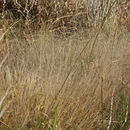Comprehensive Description
(
Inglês
)
fornecido por North American Flora
Muhlenbergia asperifolia (Nees & Mey.) Parodi, Revista Fac Agnm. Hucnos Aires 6: 117. 1928.
Vil/a asperifolia fMeyen. Rcise 1: 408, name only. 1834) Nees & Mev.; Trin. Mi'm. Acad. S(.-
P£-tersb. VI. 6': 95. 1840. Sporobolus asperifolius Nees, Nova Acta Acad. I.eop. -Carol. 19: Suppl. 141. 1843. (Based on
Vilfa asperifolia Nees & Mev.) Agroilis dislichophylla I< A. Phil.' El. Atac. 54. 1860. (Type from Chile, Parodi.) Not .1 dislidio-
phylla R. & S. 1817. Sporobolus sarmenlosa Griseb. Abh. Ges. Wiss. Gott. 24: 295. 1879. (Type from Argentina.) Sporobolus deserlicolus Phil. Anal. Mus. Nac. Chile Bot. 8: 82. 1891. (Type from Chile, fide
Parofli.) Sporobolus asperifolius var. major Vascy. Contr. U. S. Nat. Herb. 3: 64. 1892. (Type from Marfa.
Texas.) Sporoboliis dislkhophylhis Phil. Anal. ITiiiv. Chile 94: 7. 1896. (Based on Agroslis dislichophyllus
Phil.) Agroslis eremophilii Spcg. Anal. Mus. Nac. Buenos Aires 7: 190. 1902. (Based on ,4. dislichophylla
Phil.)
Perennial, pale or glaucous, with slender scaly rhizomes; culms branching at base, spreading, slender, compressed, glabrous, 10-40 cm. tall, the branches ascending or erect; sheaths compressed-keeled, usually overlapping, glabrous; ligule truncate, erose-toothed, about 0.5 mm. long; blades flat, crowded, scabrous, mostly 2-5 cm. long, 1-2 mm. wide; panicles slender, diffuse, 5-15 cm. long, about as wide, the capillary scabrous branches finally widely spreading, the panicle at maturity breaking away, the axis glabrous or nearly so, the main branches scaberulous, the branches of the second and third order (pedicels) scabrous, rather stiff, the pedicels slightly enlarged below the spikelets, much longer than the spikelets; spikelets 1.5-2 mm. long, occasionally 2-flowered; glumes acute, glabrous, scabrous on the keel, sometimes minutely and sparsely pilose on the back, from half to nearly as long as the spikelet; lemma thin, broad, minutely mucronate from an obtuse apex; palea about as long and as broad as the lemma.
Type locality: Chili (Meyen).
Distribution: Damp or marshy, often alkaline soil, along irrigation ditches and banks of streams, Illinois and Alberta to British Columbia, and southward to Texas, California, and Mexico; southern South America.
- citação bibliográfica
- Albert Spear Hitchcock. 1935. (POALES); POACEAE (pars). North American flora. vol 17(6). New York Botanical Garden, New York, NY
Physical Description
(
Inglês
)
fornecido por USDA PLANTS text
Perennials, Terrestrial, not aquatic, Rhizomes present, Rhizome elongate, creeping, stems distant, Stems nodes swollen or brittle, Stems erect or ascending, Stems geniculate, decumbent, or lax, sometimes rooting at nodes, Stems terete, round in cross section, or polygonal, Stems compressed, flattened, or sulcate, Stem internodes hollow, Stems with inflorescence less than 1 m tall, Stems, culms, or scapes exceeding basal leaves, Leaves mostly cauline, Leaves conspicuously 2-ranked, distichous, Leaves sheathing at base, Leaf sheath mostly open, or loose, Leaf sheath smooth, glabrous, Leaf sheath and blade differentiated, Leaf blades linear, Leaf blades very narrow or filiform, less than 2 mm wide, Leaf blades mostly flat, Leaf blade margins folded, involute, or conduplicate, Leaf blades mostly glabrous, Leaf blades s cabrous, roughened, or wrinkled, Ligule present, Ligule an unfringed eciliate membrane, Inflorescence terminal, Inflorescence an open panicle, openly paniculate, branches spreading, Inflorescence solitary, with 1 spike, fascicle, glomerule, head, or cluster per stem or culm, Inflorescence branches more than 10 to numerous, Flowers bisexual, Spikelets pedicellate, Spikelets laterally compressed, Spikelet less than 3 mm wide, Spikelets with 1 fertile floret, Spikelets solitary at rachis nodes, Spikelets all alike and fertille, Spikelets bisexual, Spikelets disarticulating above the glumes, glumes persistent, Spikelets disarticulating beneath or between the florets, Entire inflorescence falling intact, as a tumbleweed, Rachilla or pedicel glabrous, Glumes present, empty bracts, Glumes 2 clearly present, Glumes equal or subequal, Glumes shorter than adjacent lemma, Glumes 1 nerved, Lemmas thin, chartaceous, hyaline, cartilaginous, or membranous, Lemma similar in texture to glume s, Lemma 3 nerved, Lemma glabrous, Lemma apex truncate, rounded, or obtuse, Lemma awnless, Lemma mucronate, very shortly beaked or awned, less than 1-2 mm, Lemma margins thin, lying flat, Lemma straight, Callus or base of lemma evidently hairy, Callus hairs shorter than lemma, Palea present, well developed, Palea membranous, hyaline, Palea about equal to lemma, Palea 2 nerved or 2 keeled, Stamens 3, Styles 2-fid, deeply 2-branched, Stigmas 2, Fruit - caryopsis, Caryopsis ellipsoid, longitudinally grooved, hilum long-linear.
Muhlenbergia asperifolia: Brief Summary
(
Inglês
)
fornecido por wikipedia EN
Muhlenbergia asperifolia is a species of grass known as alkali muhly and scratchgrass. It is native to much of North America, including most of southern Canada, most of the continental United States except for the southeastern region, and parts of northern Mexico. It also grows in South America.
- licença
- cc-by-sa-3.0
- direitos autorais
- Wikipedia authors and editors

